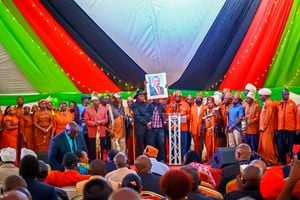Whatever you do, don’t kill the Kenyan dream
In The Kalenjin Egypt Origin Legend Revisited, Kipkoeech arap Sambu informs us that Myoot is the real name of the various “Kalenjin” sub-communities. “Kalenjin” was imposed on them by the colonial Kenya Broadcasting Service.
In the early 1940s, Towett, Koske, Seroney and other Kalenjin students at Alliance had coined the term from a word with which all the Myoot still call attention — equivalent to the Kiswahili sikiza or nasemaje or nakuambiaje, the Kikuyu atiriri, the English I say and Dholuo awachoni or winji.
But Myoot is much more interesting because it is etymologically related to Maat, the Nilotic goddess of justice, beauty and symmetry. The two elements that compose it — Ma and At or Myo and Ot — are semantically vital because the first refers to “mother” and the second to “house”.
The Kalenjin called themselves Myoot because, they said, they had all come from the same mother in a primordial house. Dholuo expresses an identical concept in similar words – Ma and Miyo for “mother” or “motherhood” and Ot for “house”.
Thus Dhoot (Dho-ot) – our word for “clan” – means “door” or, literally, “mouth of the house” – just as Dholuo literally means “mouth of the Luo”. Everybody comes from the “mouth” of a “house”, through Maat’s door.
All this is relevant to other Kenyans because they might find that all are children of a single “Eve” in the mists of time. But there is a more concrete way of looking at the origin of what we call Kenya.
Whether we are “indigenous” or “expatriate”, all of us come from a house built by colonialism. Colonial die-hards — like Massie-Blomfield — might be caressed whenever many a Philip Ochieng affirms that all Kenyans come from the same Dhoot called colonialism and objectively aspire to a larger Myoot.
Massie-Blomfield’s ignorance expresses itself in his inability to see that a people’s origin need not always be glorious.
Yet, colonialism armed me with two powerful weapons — English and a love for books — through which I can effectively retort to all colonial die-hards that colonialism was a radically evil institution.
The positive thing about our common colonial origin is that it can create in all of us — not excluding Massie-Blomfield’s progenies — the feeling of a common destiny and that, therefore, we ought to unite to hasten that destiny.
The same colonial tyranny was what once united certain individuals from all ethnic and racial groups into a common cause called nationalism.
If the Kalenjin will teach Kenyans the details of what it entails (in terms of rights and duties) to belong to Myoot — if we can learn to follow the injunctions of Maa — what can we not achieve in our will to build a larger Myoot called Kenya?
Jean-Jacques Rousseau, the celebrated Genevois political philosopher, summarised Myoot’s demands in the term “common good”.
Commitment to social beauty and symmetry — in the form of material plenty and equity and political justice — that is what Asiis demanded of all the Myoot and other Nilotes.
In a new Myoot called Kenya, that is what Cheptaleel would demand of us all — including the grandchildren of Massie-Blomfield and other Kenyans of Boer and Anglo-Saxon origins.
The point, however, is that a teacher succeeds best only if she constantly exemplifies her own moral demands. That is the prime assignment facing the Kalenjin today.
They must lead us in our present struggle to move to a higher level of legal beauty and equity so that we can approach Nirvana — as our brother Sidhartha Gautama called his conception of Myoot for Bihari of India — as soon as possible.
Thus, if the Kalenjin want to say ‘No’ to the draft constitution, let them do it from their own understanding of what Maat would have advised.
In short, if they vote ‘No’ as a community, they will have much to answer for their self-isolation and for sacrificing the nation’s dream of a higher Myoot at the altar of a self-seeker called William Ruto.




